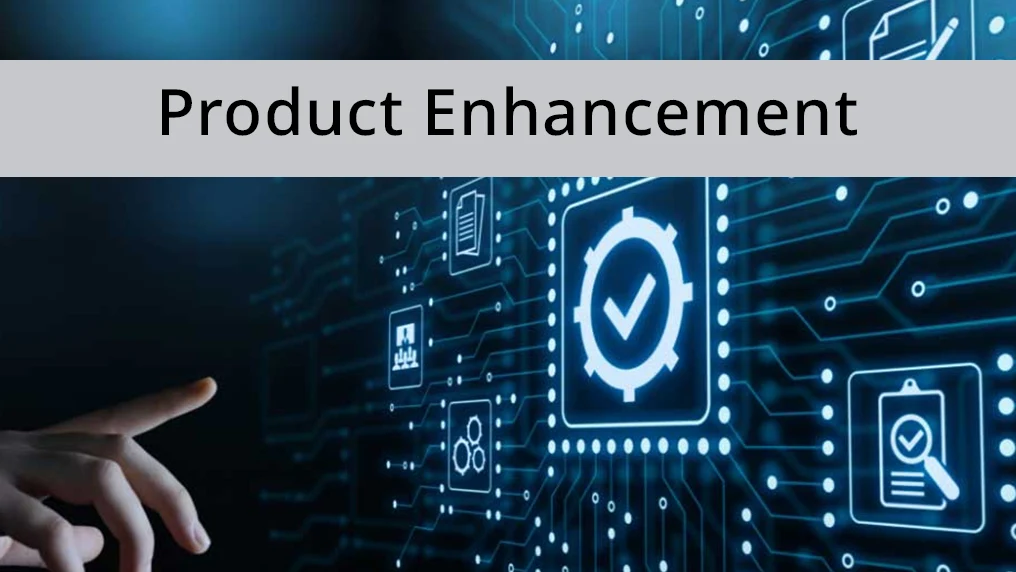
User experience forms the new business edge in competition within a digital world that is constantly changing. Given that competition is experiencing an upward trend in virtually every industry, the argument for the improvement of products to meet the expected growth in user expectations is even more significant. Ongoing enhancement of a product therefore plays the role of being ahead of the present market pressure as well as future requirements. This blog addresses the importance of product enhancement, its impact on user satisfaction and retention, and how it can be used as a strategy to promote a culture of continuous improvement in organizations. What is Product Enhancement?
Product enhancement refers to enhancing existing products by introducing new features into a product or improving existing functionalities or optimizing the general user experience. New product development involves taking new products that have just been conceptualized to market; on the contrary, product enhancement focuses more on improving the already available offerings in order to deliver greater value to the user.
Why do we Need Product Enhancement?
Adaptation to Changes in Market
They change their preferences and expectations according to the requirements of the marketplace. In a rapidly changing marketplace, this makes them seek newer and better versions regularly. It is no doubt that such companies that remain trapped in the old will lose their competitive advantage and customer loyalty.
Why is NPD Important?
They change their preferences and expectations according to the requirements of the marketplace. In a rapidly changing marketplace, this makes them seek newer and better versions regularly. It is no doubt that such companies that remain trapped in the old will lose their competitive advantage and customer loyalty.
User Satisfaction
The more pain points are addressed or new features are brought in place, the more the users are satisfied. The chances of being a loyal customer and an advocate for the brand are much higher when users are satisfied. To top it all, research has shown that 70% of buying experiences are based on the way the customer feels that they are being treated, and this user satisfaction is hence the most important factor.
Better Retention Rates
Continuous improvement of the product over time decreases churn rates. Continuous delivery of value keeps users on board, reducing the likelihood of jumping ship to the next competitor. Strong focus on user experience drives up customer retention by 5%, with profit increase by 25% to 95%.
Competitive Advantage
In a competitive market, commitment to the improvement of product is what sets the company apart. Continuous updates and improvement show a stake in the quality and care for the customers, thus boosting brand loyalty. Firms focused on product improvement have an automatic assurance of becoming industry leaders and consequently attracting other customers and partners towards them.
Revenue Growth
The best results from enhanced products are that they can bring higher sales and customer lifetime value. Organizations that concern themselves with improving their products usually face higher chances of conversion and upselling. A research from McKinsey indicates that the focus on improving the experience of the user leads to a 15% increase in sales.
The Influence of User Experience on Business Success
User Experience Definition
User experience encompasses all aspects of how an end-user interacts with a company’s service and or product. Among them are usability, design, accessibility, performance, and satisfaction in general. A good user experience gives a company a deep opportunity in building trust and loyalty, while a bad one always breeds frustration and abandonment.
Business Case for Improving User Experience
Increase Conversion Rates
It can also get better conversion rates-a seamless user experience. Forrester Research suggests that a well-developed user interface can amplify conversion by 200%. That value suggests how important it would be if one considers user experience as the core aspect of any product enhancement initiative.
Customer Loyalty Enhanced
Satisfied customers will come back. According to Accenture, 66 percent of consumers will abandon a brand because of poor service or user experience. With investments in product enhancements where user experience comes first, organizations foster loyalty and invite repeat business.
A commitment to experience ultimately translates into word-of-mouth referrals. Customers with great experiences are likely to share their stories, increasing the reputation of the brand. According to BrightLocal’s survey of consumers, 91% of them read online reviews before making a purchase decision. Customer reviews indeed have strong power on the perception of a brand.
Cost Savings
It saves the costs incurred in customer support and retention. As per a study published in Harvard Business Review, Companies that outperform their competitors by 80% growth in revenues are those that offer better customer experience. By this, it implies that having good user experience is not a cost but an investment for the future with good returns.
Critical Strategies for Continued Product Improvement
Organizations have a few key strategies they can use to effectively enhance products and improve user experience. Here are a few of them.
Regular User Feedback Collection
Why is feedback important?
Involving users in the enhancing process helps understand organizations better, their needs, and expectations. According to a survey by UserTesting, 70% of customers think companies should be more proactive in gathering user feedback.
Methods of Gathering Feedback
- Surveys and Questionnaires: Surveys should be deployed following an interaction to understand the experiences of users.
- User Interviews: One-to-one interviews with the users can be conducted to understand in-depth their experiences and expectations.
- Usability Testing: Observe users at work while they are using your product in order to identify problem areas based on usability and gather insight to enhance.
- Widgets for gathering feedback: Give way for users to offer such seamless feedback during interaction through the inclusion of feedback widgets within the interface of the product.
Agile Development Methodologies
Advantages of Agility
Agile methodologies also enable organizations to quickly respond to user feedback and provide enhancements on time. Agile helps bring in iterative development in which updates and improvements can be delivered regularly.
Principles in Agile Development
- Iterative Releases: The development process is broken down into smaller cycles (sprints) to deliver improvements more frequently.
- Collaboration: Integrate cross-functional teams of product managers, designers, and developers to facilitate easier enhancement processes.
- User Stories: The use of user stories when prioritizing features ensures the enhancements improve the life of the user and maintain their business goals.
- Real-World Insight: According to a report by Scrum Alliance, organizations implementing agile methodologies reduce their time-to-market for new features by up to 50%.
- Graphic Concept: Graphic of Agile Sprint Cycle : The agile sprint cycle in terms of planning and development, testing, and review.
Data-Driven Decision Making
Analytics Use
Data Analytics plays an important role in determining the kind of patterns or preferences of users. Organizations can use analytics to decide which features to enhance further and prioritize those which are actually working out for the user.
Key Metrics to Monitor
- User Engagement: Track time spent on the platform, feature usage, and interaction rates.
- Conversion Rates: Study the conversion metrics where enhancements could help and drive user actions. Customer Satisfaction Scores: Measure the satisfaction of the user, either in terms of NPS or CSAT.
- Churn Rates: Monitor the churn rates so that areas that are causing a user to become inactive can be determined.
Competitive Analysis Knowing the Competitions
Competitive analysis helps the organizations to understand industry trends, benchmark their offerings, compare with the competitors, and find a way whereby improvement can be made.
Steps to Perform Competitor Analysis
- Select Competitors: Identify who are direct competitors to your business in the marketplace.
- Competitor Product Analysis: Analyze the offerings of competitors, look at features; experience for the user, and gain customer feedback on their products.
- Gap Finding and Opportunities: Point out gaps in the competing products, which your organization can capitalize upon to do improvements.
Integration of Emerging Technologies
Use of Technology for Improvement
Emerging technologies can enable improved functionality and enhance the user experience of the product. Organizations must be abreast with the recent technological trends and how those might be applied to their offerings.
Key Technologies to Research
- AI Involvement: AI would help create a more personalized experience for users in order to automate the customer support function and analyze user data based on most insightful results. AI will help in predicting the needs of the users and making suggestive recommendations toward customized content that increases overall satisfaction.
- Augmented and virtual reality: Include AR and VR with your products so that it can also give users immersive experiences that are capable of involving the user on a deeper level. This technology can be extended to several industries such as real estate, education, and entertainment toward enabling interactive experiences.
- Internet of Things (IoT): Implement IoT in order to connect the products and thereby provide real-time insights into the data so that the usability of the product gets bettered and customer engagement will be enhanced. Moreover, the application of IoT technology will help in active maintenance and make the product more reliable.
- Blockchain Technology: Implement blockchain in security, transparency, and trust in regard to transactions especially in areas such as finance and healthcare.
- Cloud Computing: Employ cloud-based solutions to ensure a product’s scalability, flexibility, and accessibility to the user. Using cloud services, a team can work online in real-time and roll out updates with ease.
Critical Measurement of Success of Product Improvement

Integration of Emerging Technologies
Organizations should then derive a KPI to monitor the impact of their product improvements relative to the organizational objectives. Some of the KPIs are:
- User retention rate: This will measure the number of users who continue to utilize the product after the implementation of the enhancements.
- Customer satisfaction scores: Compare the user satisfaction before and after implementing the enhancements through surveys and other methods of feedback mechanism.
- Net Promoter Score (NPS): Measure the probability of users recommending the product to others that might help derive more about overall satisfaction and loyalty.
- Feature Adoption Rates: Measure adoption rates at which users latch onto newly introduced features to understand whether they are succeeding and usable.
- Sales Growth: Measure sales data post the enhancement if improvements made result in a rise in revenue.
- Performance Measurement Dashboard: A visual representation of a dashboard showing key metrics and KPIs related to product enhancements.
In simple words, user-centric design is basically an iterative, dynamic development process that puts emphasis on the needs and preferences of users at the very onset of the development cycle. Involving users at every step will ensure that everything which has been developed regarding enhancements is related to the practical need and expectations of the users.
Involvement of the User
- User Involvement at the Start: Engage with the users at the very beginning with whatever user insight and feedback can be generated to help or influence product enhancements.
- Iterative Testing: All the usability problems identified during user testing should be documented in terms of usability problems and feedback from users for design modifications
Knowing User Context
It is essential that the context or environment in which the user operates the product and the goals, tasks, and environment of the user are considered.
Benefits of User-Centered Design of Product Upgrade
- Usability: Improvement, with consideration of users, is more likely to yield intuitive as well as easy usability for the product.
- Increased User Satisfaction: Changes that address real pain points of actual users bring more happiness and loyalty.
- Reduced Development Expenditures: The likelihood of costly deviations during later development stages is extremely diminished if the usability issues are found as soon as possible.
Future of Product Improvement

Trends to Monitor
- AI and Machine Learning: Continuously on an up-trend, AI and ML in product enhancement would continue to cater to analyzing user data for insights and allowing the organizations to automate personalization. In that regard, AI would be used to create actionable insights informing enhancement strategies, thus making the product much better tailored to the user experience. Customer support and engagement would improve using AI-powered chatbots.
- Growing Focus on Sustainability: Because consumers are becoming increasingly aware of the environment, organizations will place even greater emphasis on sustainable product enhancements to address the various market requirements. These will include environment-friendly materials, reducing waste, and increasing energy efficiency in the design of products. Brands that demonstrate a commitment to sustainability often build much stronger connections with the customers.
- Introduction of AR/VR: In AR and VR technology, both are designed with the aim of enriching products in which the user will feel it by engrossing oneself through lively interaction. The technology can be adapted to any industry, such as real estate or education and entertainment, in creating interactive experiences. For instance, virtual showrooms may allow customers to explore products in realistic surroundings.
Remote Collaboration Tools
As remote work becomes the new norm, organizations will be embracing collaboration tools to ensure continued product development across teams. Tools that make it possible to collaborate in real-time, such as Figma or Miro, help people stay productive and creative. It underlines communication and teamwork, no matter the location.
- Omni-Channel Experiences: Users will also increasingly expect seamlessness across platforms and channels. The organization will have to strengthen the product to ensure integrated experiences are constant whether a user is using an in-store interface, a website, or mobile app. This, therefore calls for a uniform strategy on how branding and messaging will integrate and replete across channels.
- Hyper-Personalization: Organizations will tap into big data and AI and focus on hyper-personalization-a way of delivering experiences that are catered to an individual’s preferences and behaviors. In doing so, their satisfaction and engagement among end-users will be increased. For example, recommending specific content will have far-reaching implications for making their marketing messages more relevant. Increased Investment in Security Features.
Organizations will be concerned with product security, considering increased issues of data privacy and security. Advanced encryption and authentication methods will be critical in maintaining user trust. There is no doubt that users will be better disposed towards products designed with a clear commitment towards data safety.
Technological changes are fast; thus, firms must be continually learning and updating skills, processes, and technologies to understand the occurring changes in the markets. This aspect can be achieved through training programs and workshops that inform employees about the latest changes in their different fields. Secondly, Voice and conversational interfaces involve the integration of voice and human-like conversation interfaces into intelligent systems. This is essentially a special form of natural language communication- innovative, and somewhat new for most companies that design applications.
Moving forward, with the advancement of voice technology, organizations will opt for integrating voice and conversational interfaces with their products. This will help access issues and provide an intuitive form of user interaction.
- Accessibility Focus: Much focus will be on accessibility features of product improvement so that companies’ offerings reach a wide range of people, among them having disabilities. Access best practice implementation can expand the customer base and show willingness to include all customers.
Conclusion
An era of such user expectations calls for the fact that no significance of product improvement be compromised. Companies keen to continue to improve their products enhance users’ satisfaction and loyalty, thereby sustaining an organization’s long-term success.
Companies are able to deal with the demands of existing customers only if proper strategies are devised and incorporated into the business plan that makes a company’s product successful. For instance, obtaining feed back from the users; agile methodologies; and usage of emerging technologies may act as valuable source for businesses that are eager to improve and sustain their products in such markets.
Is your organization ready to take its products into the next level and enhance the general user experience?
Consult i-verve today and learn how our product enhancement services can help you sustainably grow and ensure profitable market satisfaction in this competitive market!

